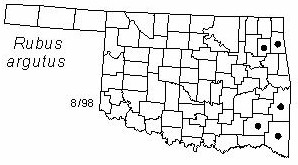Erect or upright shrubby vine to 1.2 m (4 ft) tall. Twigs slender with scattered, straight prickles 5 mm (0.2 in) or less long. Leaves alternate, palmately compound, 3-5 foliate; leaflets lanceolate; lightly pubescent on the veins beneath, dull green above; tapering at base; acuminate at apex; margins doubly or acutely serrate; petiole and rachis slender, pubescent, with few spines. Inflorescence a terminal raceme, with 5-12 flowers, subtended by a leafy bract; calyx 5-lobed and pubescent; petals 5, white, rounded; pistils many, inserted on hypanthium; stamens numerous; flowers appear from April to May. Fruit an aggregation of drupelets, 6-15 mm long (0.25-0.65 in), oblong, black; nutlets yellow; fruits mature May to June.
Distribution: Oklahoma, Alabama, Georgia, Kentucky, and Virginia.
Habitat: upland prairies and dry woodlands.
Comment: Rubus is a Roman name meaning red; argutus means "sharp tooth".
Field identification: sharp-toothed dewberry is closely related to R. ostryifolius. Rubus is a complex genus. Species are difficult to identify due to frequent hybridization and introgression.
Food uses: fruits can be eaten raw or used in jams, jellies, and sauces.
Wildlife benefits: dewberry fruits are eaten by many species of birds and mammals.
NWI status: FACU-,FAC-.
Distribution in Oklahoma: 
BACK
NEXT
RETURN TO INDEX
Last update: 9/17/99
 Go to Oklahoma Biological Survey Home Page
Go to Oklahoma Biological Survey Home Page
 Disclaimer
Disclaimer